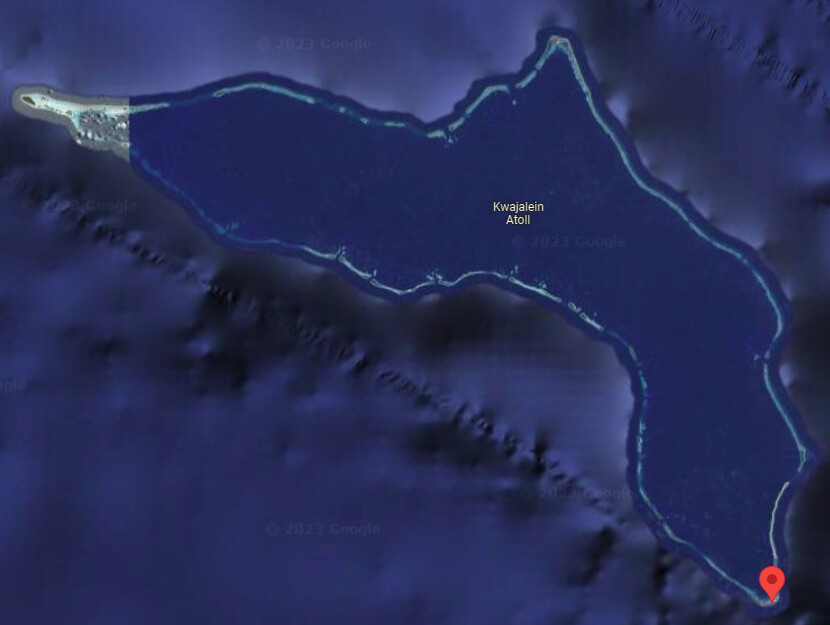The Pittsburgh Press (February 6, 1944)
Kwajalein Island cleared of Japs, two others taken
U.S. invaders of Marshalls seize first goals; other atolls and Wake blasted by U.S. fliers
By William F. Tyree, United Press staff writer
First Yank objectives in the Marshalls invasion have been won with the wiping out of the last Japs on Kwajalein Island and capture of the seaplane base of Ebeye and Loi Island, which out 18 or 20 islands of the Kwajalein Atoll in American hands. In the Solomons to the southwest, U.S. forces crossed Bougainville’s interior mountain range and drive to within five miles of the east coast. Allied fliers knocked out 80 Jap planes in one day’s raid in the New Guinea area.
Pearl Harbor, Hawaii – (Feb. 5)
U.S. 7th Division troops have blasted the Japanese out of their last pillboxes on Kwajalein Islet, the principal island in Kwajalein Atoll, and U.S. planes have again ranged far out on the road to Tokyo to batter the enemy on Wake and Eniwetok Islands, it was announced today.
Maj. Gen. Charles H. Corlett’s troops also captured the seaplane base of Ebeye and the adjoining Loi Island, both near Kwajalein Islet.
An 11-word communiqué from Adm. Chester W. Nimitz revealed that the main objectives had been seized in the opening blow of the offensive against Japan’s pre-Pearl Harbor Empire and a Navy communiqué disclosed the new air blows against the Japanese flanks in the Marshall Islands area,
Wake’s third in week
Two squadrons of Consolidated Coronado seaplanes bombed Wake Island the night of Feb 4-5, handing its third battering since Monday to that outpost where a handful of Marines waged an immortal defense after Pearl Harbor. Wake is approximately 700 miles north and slightly east of Kwajalein.
Carried-based planes, meanwhile, had struck 300 miles northwest of Kwajalein Thursday, bombing Eniwetok which is the westernmost bastion and only 800 miles from the enemy stronghold of Truk. Many tons of bombs were loosed on the airfield and on a nearby concentration of tanks.
Lighter aircraft kept up assaults in the Marshalls area. Warhawk fighters bombed and machine-gunned Mili Atoll Thursday and Army medium bombers sank a small freighter off Imieji Islands in Jaluit Atoll and bombed the island. No planes were lost in these operations.
20 islands captured
Adm. Nimitz’s announcement of the capture of the three islets brought to twenty the number in the Kwajalein Atoll now in U.S. hands.
The terse victory announcement said:
Kwajalein, Ebeye and Loi Islands have been captured by our forces.
Kwajalein is the administrative seat of the atoll while Loi lies five miles to the north and Ebeye is in between the two.
Other landings probable
There was a strong probability that Americans had landed on other islands, with the Japs helpless to resist them under Allied air and naval blows. Some of the islands had been swept clean of the enemy in a matter of minutes after the soldiers or Marines, who were working the northern part of the chain, had landed.
The final phase of the capture of Kwajalein Islet was a mop-up job since Maj. Gen. Corlett’s troops quickly won control of the island’s main fortifications and only had to clean out scattered pillboxes with grenades and flamethrowers.
The remainder of Ebeye was captured after Army troops won about half of the island in their first landing assault. Loi fell quickly when the soldiers swept ashore after an air-naval hammering. The island of Gugegwe, four and a half miles north of Loi, was pounded in the same pre-landing attack, but that strand was not mentioned in Adm. Nimitz’s announcement.
Remaining Japs helpless
In six days, the Americans had won complete control of the northern and southern extremities of the 70-mile, elongated atoll and whatever Japs remained on the western islets were in a virtually hopeless position.
The cost had been low as the Americans’ conquests now included the following islands: Kwajalein, Ebeye, Gagen, Edgell, Debuu, Edgigen, Abella, Ennubirr, Ennugarett, Ennumennet, Loi, Roi, Namur, Gehh, Ennuouj, Ninni, Millu, Boggerlap, and two unidentified spits.
This list included seven more small strands of coral and sand seized by Maj. Gen. Harry Schmidt’s 4th Marines at the northern end of the chain after they had consolidated Roi and Namur, the most important military bases in the atoll.
Cover in pillboxes
On Kwajalein Island, the main peril was from Jap snipers who cowered in their pillboxes and waited fatalistically for death.
No Jap counterattacks were made yesterday and U.S. losses were remarkably light. In one interconnected blockhouse system, 250 Japs were found dead.
A Jap Dōmei broadcast virtually admitting that the enemy will not attempt a counteroffensive in the Marshalls said that “as the main force of our Navy remains intact, it will select the most advantageous time and place to sally forth for the defense of Greater East Asia.”
Jap Premier Hideki Tōjō, quoted in a Tokyo broadcast, told the Japanese House of Representatives that the war is “increasing in ferocity day by day and we now are being confronted with a situation where the fate of Greater East Asia will be decided.”

